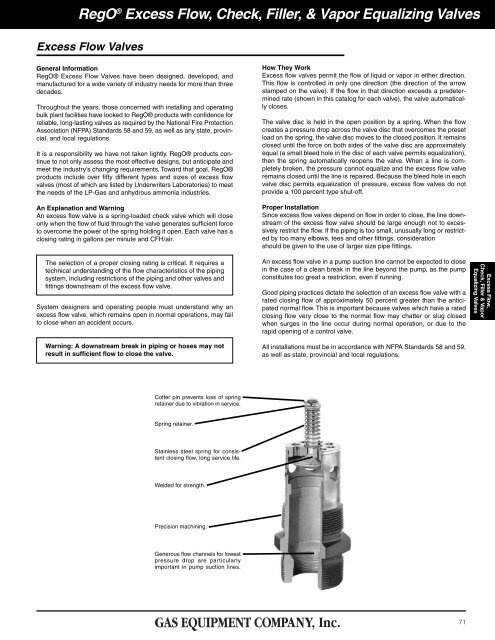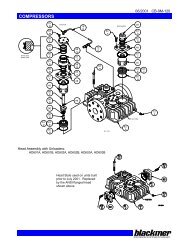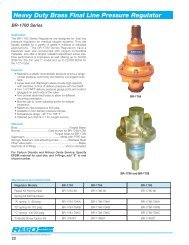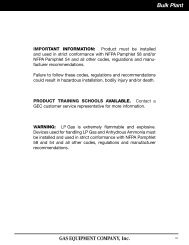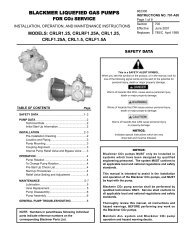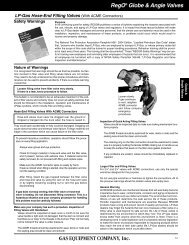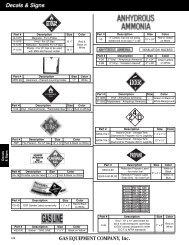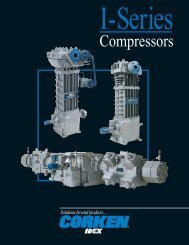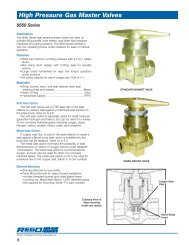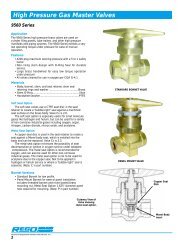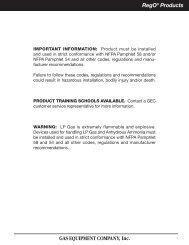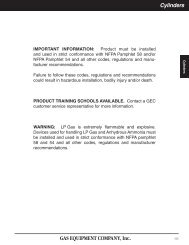RegO ® <strong>Excess</strong> <strong>Flow</strong>, <strong>Check</strong>, <strong>Filler</strong>, & <strong>Vapor</strong> <strong>Equalizing</strong> <strong>Valves</strong>The Limitations of <strong>Excess</strong> <strong>Check</strong> <strong>Valves</strong> for LP-Gas<strong>Excess</strong> <strong>Flow</strong>,<strong>Check</strong>, <strong>Filler</strong> & <strong>Vapor</strong><strong>Equalizing</strong> <strong>Valves</strong><strong>Excess</strong> flow check valves have been of help in limiting gas loss inmany incidents involving breakage of hoses and transfer piping. Thus,they do provide a useful safety function in LP-Gas systems. However,there have also been transfer system accidents where excess flowvalves have been ineffective in controlling gas loss due to a variety ofconditions and to the inherent limitations of these valves. This bulletinexplains what protection excess flow valves can offer, points out conditionswhich can interfere with that protection, and offers suggestionsfor effective excess flow valve installation.An excess flow valve is a protective device to help control the dischargeof product in the event of complete breakage of pipe lines orhose rupture. However, an excess flow valve can only offer limitedprotection from gas discharge, because it will only close under thoseconditions which cause the flow through the valve to exceed its ratedclosing flow, and even when closed it necessarily allows some “bleed”past the valve.An excess flow valve is not designed to close and thus may notprovide protection, if any of the following conditions are present:1. The piping system restrictions (due to pipe length, branches, reductionin pipe size, or number of other valves) decrease the flow rateto less than the valve’s closing flow. (Valve should be selected byclosing flow rating — not just by pipe size).2. The break or damage to the downstream line is not large enough toallow enough flow to close the valve.3. A shut-off valve in the line is only partially open and will not allowenough flow to close the excess flow valve.4. LP-Gas pressure upstream of the excess flow valve, particularlydue to low temperature, is not high enough to produce a closingflow rate.5. Foreign matter (such as welding slag) is lodged in the valve andprevents its closing.6. A buildup of process material (sludge), which may be found inLPGas, may occur over a period of time and cause the valve tostick open.Where excess flow valves are installed, they should be checkedto see that:1. They are installed in the correct direction — the arrow on the valveindicates the shut-off direction.2. The flow rating on the valve is proper for the installation. The ratingmust be above the normal system flow, but not higher than necessaryto prevent “nuisance” closing in normal conditions. If themanufacturer’s catalog information is not sufficient, the valvesuppliers can provide sizing assistance.3. In-line excess flow valves are installed so likely piping damage willoccur downstream of the valve and will not separate the valvefrom the upstream piping.When the excess flow valves can be examined separate from theline (before the installation or if removed for system maintenance),they should be checked to see that the parts are in good conditionand that the poppet can be pushed fully closed.Testing of <strong>Excess</strong> <strong>Flow</strong> <strong>Valves</strong>In order to test an excess flow valve in a piping system, the flowthrough the valve must be made to exceed the valve’s closingrating.This testing should only be attempted by trained personnel familiarwith the process. If no one at the facility has experience inproper testing, outside expert help should be obtained. The exactprocedure used may vary with the installation, advisability of gasdischarge, and availability of equipment.In general, most testing makes use of the fact that excess flowvalves are “surge sensitive” and will close quicker under a suddenflow surge than under steady flow. A sufficient surge can often becreated by using a quick-closing valve to control sudden, momentaryflow into a tank or piping section containing very low pressure.An audible click from the excess flow valve (and correspondingstoppage of flow) indicates its closure.A test involving venting gas to the atmosphere is hazardous andmay be impractical, or illegal.7. The piping break or damage occurs upstream of an in-line excessflow valve, so the escaping product is not passing through thevalve.8. The flow through the valve is in the wrong direction. (<strong>Excess</strong> flowvalves only respond to flow in one direction.)Any test of any excess flow valve will not prove that the valve willclose in an emergency situation, due to reasons cited before. Thistest will only check the valve’s condition, and the flow rate sizingfor those test conditions.For additional information on excess flow valves and other meansof shut-off protection, contact REGO® and refer to NFPA 58.9.The excess flow valve has been damaged, or is otherwise not inoperating condition.Because of these limitations of excess flow valves, they should not berelied upon as the only means of controlling the escape of product inthe event of piping damage. When possible, shut-off protection byquick closing valves, with shut-off controls accessible in spite of likelyline damage, should be provided in addition to, or instead of excessflow valves.Prepared byNATIONAL PROPANE GAS ASSOCIATIONThe purpose of this bulletin is to set forth general safety practices forthe installation, operation, and maintenance of LP-Gas equipment. It isnot intended to be an exhaustive treatment of the subject, and shouldnot be interpreted as precluding other procedures which wouldenhance safe LP-Gas operations. The National Propane GasAssociation assumes no liability for reliance on the contents of thisbulletin.70
RegO ® <strong>Excess</strong> <strong>Flow</strong>, <strong>Check</strong>, <strong>Filler</strong>, & <strong>Vapor</strong> <strong>Equalizing</strong> <strong>Valves</strong><strong>Excess</strong> <strong>Flow</strong> <strong>Valves</strong>General InformationRegO® <strong>Excess</strong> <strong>Flow</strong> <strong>Valves</strong> have been designed, developed, andmanufactured for a wide variety of industry needs for more than threedecades.Throughout the years, those concerned with installing and operatingbulk plant facilities have looked to RegO® products with confidence forreliable, long-lasting valves as required by the National Fire ProtectionAssociation (NFPA) Standards 58 and 59, as well as any state, provincial,and local regulations.It is a responsibility we have not taken lightly. RegO® products continueto not only assess the most effective designs, but anticipate andmeet the industry’s changing requirements. Toward that goal, RegO®products include over fifty different types and sizes of excess flowvalves (most of which are listed by Underwriters Laboratories) to meetthe needs of the LP-Gas and anhydrous ammonia industries.How They Work<strong>Excess</strong> flow valves permit the flow of liquid or vapor in either direction.This flow is controlled in only one direction (the direction of the arrowstamped on the valve). If the flow in that direction exceeds a predeterminedrate (shown in this catalog for each valve), the valve automaticallycloses.The valve disc is held in the open position by a spring. When the flowcreates a pressure drop across the valve disc that overcomes the presetload on the spring, the valve disc moves to the closed position. It remainsclosed until the force on both sides of the valve disc are approximatelyequal (a small bleed hole in the disc of each valve permits equalization),then the spring automatically reopens the valve. When a line is completelybroken, the pressure cannot equalize and the excess flow valveremains closed until the line is repaired. Because the bleed hole in eachvalve disc permits equalization of pressure, excess flow valves do notprovide a 100 percent type shut-off.An Explanation and WarningAn excess flow valve is a spring-loaded check valve which will closeonly when the flow of fluid through the valve generates sufficient forceto overcome the power of the spring holding it open. Each valve has aclosing rating in gallons per minute and CFH/air.Proper InstallationSince excess flow valves depend on flow in order to close, the line downstreamof the excess flow valve should be large enough not to excessivelyrestrict the flow. If the piping is too small, unusually long or restrictedby too many elbows, tees and other fittings, considerationshould be given to the use of larger size pipe fittings.The selection of a proper closing rating is critical. It requires atechnical understanding of the flow characteristics of the pipingsystem, including restrictions of the piping and other valves andfittings downstream of the excess flow valve.System designers and operating people must understand why anexcess flow valve, which remains open in normal operations, may failto close when an accident occurs.An excess flow valve in a pump suction line cannot be expected to closein the case of a clean break in the line beyond the pump, as the pumpconstitutes too great a restriction, even if running.Good piping practices dictate the selection of an excess flow valve with arated closing flow of approximately 50 percent greater than the anticipatednormal flow. This is important because valves which have a ratedclosing flow very close to the normal flow may chatter or slug closedwhen surges in the line occur during normal operation, or due to therapid opening of a control valve.<strong>Excess</strong> <strong>Flow</strong>,<strong>Check</strong>, <strong>Filler</strong> & <strong>Vapor</strong><strong>Equalizing</strong> <strong>Valves</strong>Warning: A downstream break in piping or hoses may notresult in sufficient flow to close the valve.All installations must be in accordance with NFPA Standards 58 and 59,as well as state, provincial and local regulations.Cotter pin prevents loss of springretainer due to vibration in service.Spring retainer.Stainless steel spring for consistentclosing flow, long service life.Welded for strength.Precision machining.Generous flow channels for lowestpressure drop are particularlyimportant in pump suction lines.71
- Page 1 and 2: RegO ® Excess Flow, Check, Filler,
- Page 3: RegO ® Excess Flow, Check, Filler,
- Page 7: RegO ® Excess Flow, Check, Filler,
- Page 10 and 11: RegO ® Excess Flow, Check, Filler,
- Page 12 and 13: RegO ® Excess Flow, Check, Filler,
- Page 14 and 15: RegO ® Excess Flow, Check, Filler,
- Page 16 and 17: RegO ® Excess Flow, Check, Filler,
- Page 18: RegO ® Excess Flow, Check, Filler,


